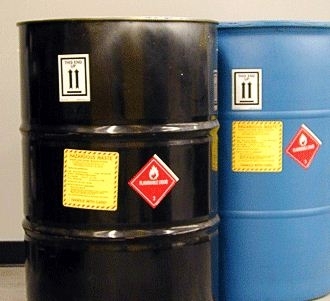Hazardous Waste
Hazardous Waste Management Plan
Each laboratory has a designated space where hazardous waste is accumulated. All such waste must be collected in the lab in clearly labeled bottles that are tightly capped. It is recommended that waste be reagent/chemical specific, but waste reagents may be mixed if they are of the same category of waste and not capable of reacting with other wastes stored in the same container. When waste is ready for storage, it may be moved to the hazardous waste accumulation area. Follow the procedure found in Unit specific plans for securing and logging the waste in the designated waste area. If present, follow the directions on the door and fill out the log with the category and amount of waste, container type, and date. (Labels are available from the Lab Supervisor.) Transporting of hazardous waste between buildings or campuses shall be according DOT Regulations.

Waste Characterization
- Each Principal Investigator or Lab Supervisor lab must identify each waste stream and proper disposal procedures for wastes generated in the lab. University EH&S staff are available to assist with identification to ensure consistency with waste disposal requirements.
- Each lab must have appropriate containers and waste accumulation areas for waste identified in their lab. Do not place incompatible waste into a single waste container.
- Click here for GVSU's Bulk Waste Container List.
Container Management
- Waste chemicals accumulated in the laboratory must be placed into containers that are in good condition, compatible with the contents, and able to be closed. Waste containers should be kept clean with no visible contamination on the outside of the container.
- Waste containers must remain be closed when not adding or removing waste.
- Waste containers must be labeled with:
- The words Waste Lab Waste or Hazardous Waste
- The name or type of chemical such as Acetone or non-halogenated solvent
- The date accumulation started and the name of the person or class generating the waste.
- Any other descriptions about the contents pertinent to the disposal facility. Provide as much detail as possible. If unknown list any details that might assist with characterizing the waste.
- Areas where waste chemicals are accumulated must have secondary containment sufficient to collect any incidental spills from container failure. Containers should not be overfilled. Leave headspace to allow for expansion and store the filled waste containers in a secure area.
- Click here for hazardous waste labels.
Waste Disposal
- Hazardous waste is accumulated in the Hazardous Waste Storage area for each GVSU facility. Instructions are provided on the door of the storage room for inventorying and labeling of waste containers.
- A licensed waste hauler is contracted to make hazardous waste pickups as needed, but not less than once per year.
- Manifest tracking
- Designated person from GVSU signs off on pick-up,
- GVSU retains the generator copy, Transporter keeps all others.
- Facility Signed Copy is mailed back to GVSU after delivery is complete and us kept for 3 years. State of Michigan must also be provided with a copy from either GVSU or the disposal facility, depending upon arrangements made with the disposal facility.
- Copies of universal waste manifests are kept in the universal waste file and log is updated. Exception: For universal waste (i.e. needles, elemental mercury, etc.) there will be no white copy received or sent back to Michigan DEQ.
- All hazardous chemical waste should be segregated and labeled according to GVSU waste disposal guidelines. Special attention should be given to the following areas:
- Glass containing no hazardous material must be kept in receptacles labeled Broken Glass.
- Chemical waste is to be collected in containers labeled "Hazardous Waste", the category of hazard, the specific chemical or reagent if known and the date.
- Items such as mercury thermometers, used florescent light bulbs, and waste rechargeable batteries must be labeled with the words Universal Waste
- Use separate containers for metal, glass and plastic sharps. Collect sharps contaminated with biohazardous materials in rigid, leakproof, puncture resistant containers which have been labeled with the universal biohazard symbol (see example above).
